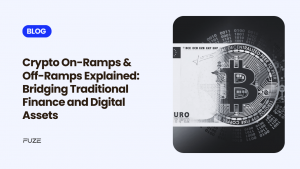As the underlying technology for cryptocurrencies like Bitcoin and Ethereum, Distributed Ledger Technology (DLT) offers a new paradigm for how data is stored, verified, and shared across networks. By providing a transparent, secure, and decentralized system for recording transactions, DLT is poised to revolutionize the way payments are processed, transforming industries ranging from banking to e-commerce and remittances.
In this blog, we will explore the top use cases of Distributed Ledger Technology in modern payment systems, highlighting its impact on efficiency, security, and accessibility in the global financial ecosystem.
What is Distributed Ledger Technology (DLT)?
Distributed Ledger Technology (DLT) refers to a system where data is stored across multiple locations or “nodes” instead of relying on a single centralized repository. This structure allows simultaneous access and verification of data keeping the network decentralized and open-to-all.
DLTs ensure secure and accurate data storage through the use of cryptographic techniques. Access to the information is controlled via “keys” and cryptographic signatures. Once recorded, the data becomes part of an immutable database, with the ledger’s functionality governed by the network’s rules embedded in its programming.
The most well-known application of DLT is blockchain, the technology behind cryptocurrencies. However, DLT can also exist in other forms, such as Directed Acyclic Graph (DAG) and Hashgraph, each offering different ways of achieving consensus and recording transactions.
Now that we understand what DLT is, let’s dive into its key use cases in modern payment systems.
1. Cross-Border Payments
One of the most significant challenges in traditional payment systems is the inefficiency and cost associated with cross-border transactions. The current process often involves multiple intermediaries, including correspondent banks, which can result in long delays and high fees. DLT addresses these challenges by enabling faster, cheaper, and more secure cross-border payments.
Using DLT, financial institutions can process cross-border transactions directly, without relying on intermediaries. Blockchain-based networks like Ripple’s XRP, Stellar, and SWIFT GPI (Global Payments Innovation) are already making strides in this space. They enable real-time settlements of international payments, reducing the need for manual intervention and eliminating multiple layers of fees.
By eliminating intermediaries and offering greater transparency, DLT allows for near-instant, low-cost, and secure international payments. This has the potential to transform the global remittance industry, which is valued at hundreds of billions of dollars annually.
Key Benefits:
- Reduced transaction fees: By cutting out intermediaries.
- Faster transactions: Real-time or near-instant settlement times.
- Increased transparency: Enhanced visibility for both parties in the transaction.
2. Real-Time Payments
DLT is also revolutionizing real-time payments, offering a secure and efficient method for individuals and businesses to send and receive money instantly. Traditional banking systems often involve delays due to the involvement of multiple intermediaries and settlement times. With DLT, payments can be processed in real-time, eliminating these delays.
The use of blockchain technology in real-time payments ensures that transactions are processed securely, reducing fraud risks and improving overall trust. For example, central banks and financial institutions around the world are exploring the use of DLT to enable instant settlement of payments across their networks. Platforms like the UK’s Faster Payments Service (FPS) and the European Union’s SEPA Instant Credit Transfer are examples of initiatives leveraging DLT for faster payment systems.
Key Benefits:
- Instant payment processing: Reducing delays in transactions.
- Reduced risk of fraud: Blockchain’s transparency and immutability.
- Improved liquidity: Businesses and individuals benefit from instant access to funds.
3. Peer-to-Peer (P2P) Payments
Peer-to-peer (P2P) payments have seen tremendous growth in recent years, with services like PayPal, and Zelle allowing users to transfer funds directly to one another. DLT can further enhance these platforms by providing greater security, efficiency, and decentralization.
By integrating DLT into P2P payment systems, users can send funds without relying on central authorities like banks or payment processors. Blockchain networks, such as Ethereum and Bitcoin, enable decentralized peer-to-peer transactions that are transparent, irreversible, and secure.
Moreover, DLT-based P2P payment systems can lower transaction fees and make cross-border P2P transfers easier, as they eliminate the need for traditional banking infrastructure. This makes it especially attractive for remittances and international money transfers.
Key Benefits:
- Reduced fees: Lower cost compared to traditional methods.
- Greater security: Blockchain’s immutability ensures that transactions cannot be altered.
- Decentralization: Removes the need for intermediaries, enhancing user control.
4. Smart Contracts for Automated Payments
Smart contracts are self-executing contracts with the terms of the agreement directly written into code. DLT allows for the creation and execution of smart contracts, enabling automatic execution of payments when predefined conditions are met.
For example, in supply chain management, a smart contract could automatically release payment once goods are delivered. In the real estate industry, smart contracts can automate rental payments and escrow services, eliminating the need for intermediaries and reducing the potential for fraud. Platforms like Ethereum have popularized the use of smart contracts, and many industries are exploring their integration into payment systems for more efficient, automated transactions.
Key Benefits:
- Automation: Payment processes are triggered automatically by predefined conditions.
- Reduced fraud: Transparent and tamper-resistant contract execution.
- Efficiency: Eliminates the need for manual intervention or third-party verification.
5. Supply Chain Payments and Settlement
Supply chain management involves multiple parties, including suppliers, manufacturers, and logistics providers, which can make payment and settlement processes complex and prone to delays. DLT can streamline these processes by creating a transparent, secure, and efficient system for tracking and verifying transactions across the supply chain.
Using DLT, all parties in the supply chain can access real-time information about transactions, inventory, and payments, reducing delays and improving the accuracy of payment records. This ensures that payments are made promptly and accurately, fostering trust and improving cash flow for all parties involved.
Key Benefits:
- Improved transparency: All parties have access to the same information in real-time.
- Faster settlements: Payments can be processed immediately once conditions are met.
- Improved trust: Reduces the likelihood of disputes and fraud.
6. Improving Payment Security with DLT
Security is a major concern in traditional payment systems, which are often vulnerable to fraud, data breaches, and cyber-attacks. DLT enhances security by providing a transparent, immutable ledger of transactions, which is resistant to tampering and fraud.
In payment systems, DLT can help ensure the integrity of transaction data, reduce the risk of fraud, and protect sensitive customer information. The decentralized nature of blockchain means that there is no central point of failure, which significantly reduces the risk of hacking or data loss.
Key Benefits:
- Enhanced security: Blockchain’s encryption and immutability protect transaction data.
- Reduced fraud risk: Decentralization and transparency make fraudulent activity easier to detect.
- Data privacy: Blockchain offers more control over personal data and transaction history.
Conclusion
Distributed Ledger Technology (DLT) is rapidly transforming modern payment systems, offering new opportunities for improving the efficiency, security, and accessibility of financial transactions. From cross-border payments and real-time settlements to decentralized peer-to-peer transfers and central bank digital currencies, DLT is paving the way for a new era in digital finance.
As more industries explore and adopt this technology, the potential for DLT to reshape the global payment landscape is immense, making transactions faster, cheaper, and more secure for everyone involved. Fuze is at the forefront of this revolution, offering innovative solutions that leverage DLT to empower businesses with seamless, secure, and scalable payment systems tailored to the needs of a digital-first economy.
Disclaimer: Virtual assets carry significant risks, including high volatility and potential loss of your entire investment. They are not backed by governmental protections, and recourse may be limited in case of loss. Always assess your risk tolerance, fully understand the risks, and seek independent financial advice if needed before investing.
Frequently Asked Questions
- Can DLT help in reducing fraud in payment systems?
Yes, DLT’s immutable and transparent nature makes it nearly impossible to alter transaction records, significantly reducing fraud and unauthorized access. - What role does DLT play in remittances?
By cutting out middlemen and offering low-cost, secure networks, DLT revolutionizes the remittance industry, making it faster and more affordable for users globally. - How does DLT improve payment transparency and auditability?
All transactions on a DLT are recorded on a shared ledger, enabling real-time access and comprehensive audit trails, fostering trust and accountability in payment systems. - Are smart contracts in DLT useful for payment automation?
Absolutely! Smart contracts automate payment processes by executing predefined rules, ensuring secure, error-free, and efficient transactions without manual intervention. - How does DLT support micropayments in digital economies?DLT’s low transaction costs and scalability make it ideal for facilitating micropayments, especially in industries like content streaming, gaming, and IoT-enabled services.







